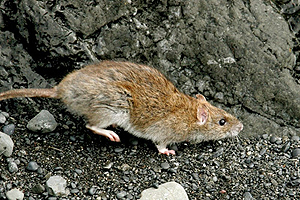Rat Island may be due for a name change
Rat Island may be due for a name change
Submitted by Ned Rozell
Phone: 907-474-7468
08/21/08


Far off in the western Aleutians, Rat Island is closer to Hokkaido than it is to Anchorage. About the size of Homer, Rat Island is green and stormy, and prone to very large earthquakes. Rat Island’s main residents are rats, the first rats ever to live in Alaska. They may not be there much longer.
Biologists with the Alaska Maritime National Wildlife Refuge will try to rid Rat Island of its namesake this fall. During a 45-day campaign also sponsored by the Nature Conservancy and Island Conservation, a team of biologists and helicopter pilots will carpet the island with grain pellets that contain an ingredient deadly to rats.
If they succeed, refuge managers will have removed rats from an island in Alaska for the first time. Biologists have done the same on about 300 islands around the world, including islands in New Zealand, atolls near Hawaii, and an island off the coast of California.
Rat Island currently is home to thousands of Norway rats, which are probably the descendants of rats that got on the island from a Japanese shipwreck in about 1780, according to Steve Ebbert, the refuge’s lead man on the current rat-removal project and the invasive species biologist. Refuge managers have removed exotic arctic foxes from more than 40 of Aleutian islands since the 1940s (including Rat Island in 1984), but this will be their first try at large-scale rat removal.
"It’s our mandate as a refuge to conserve, protect, and enhance seabird habitat," Ebbert said. "Rats have occupied (Rat Island) for 200 years--there’s no place there inaccessible to rats."
Seabirds are an easy target for rats, which eat eggs and young birds of burrow-nesting species like puffins, auklets, and ancient murrelets. The rats of Rat Island have survived an island without many birds by eating insects, seeds, and fare from the sea. A nearby islet off the coast of Rat Island that is rat-free has healthy populations of seabirds that nest in burrows.
"It’s probably representative of what Rat Island could become," Ebbert said. The rat-removal team will gear up in mid-September and will stay on Rat Island until November 15th, when their supplies will run low and the weather will turn more brutal than normal. Two helicopters will hopscotch from Anchorage to Rat Island, and then pilots will use a bucket-spreader to cover the entire island twice with pellets that look like small nuggets of dog food. Each pellet contains a blood anticoagulant that will kill rats within a few days. Refuge staff tested the bait on small islands off Adak, finding that 85 percent of the pellets were gone in four days, and that rats disappeared from those islands, at least for a short while.
Ebbert and other refuge managers are planning to kill every rat on the island; the survival of one pregnant rat would result in more rats. Biologists will check the island for rats and rat sign for the next two years. If it’s clean by then, the team will consider the $3 million project a success.
While Rat Island is now a quiet place with the sounds of surf and wind, refuge biologists hope that after 2008 it becomes noisy with sea birds, returning to the way it must have been centuries ago, before a Japanese ship ran aground.
This column is provided as a public service by the Geophysical Institute, University of Alaska Fairbanks, in cooperation with the UAF research community. Ned Rozell is a science writer at the institute.


